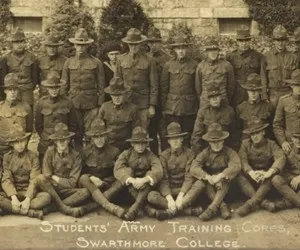On Veterans Day, Remembering Swarthmore During the Great War

Student Army Training Corps cadets in front of Parrish Hall, 1918
One hundred years ago on Nov. 11, 1918, the winds of war that had swept across the globe finally ceased, as an armistice between the Allies forces and Germany brought an end to the fighting on the Western front of the First World War.
From the start of fighting in the World War I in 1914, the College hoped to maintain its long-standing commitment to pacifism. In fact, President Joseph Swain spoke out against the war in front of a House of Representatives hearing committee. But when the United States entered the fighting in 1917, the College found itself wrestling with a commitment to the fight and its Quaker heritage.
Throughout the war, especially in the early years, several members of the faculty were prominent in the peace movement. Among them was historian William I. Hull, who served as a trustee of the New Peace Union and as a delegate to the International Conference of Education at the Hague. In 1917, Jesse Holmes, a popular philosophy professor, helped found the American Friends Service Committee, which provided young Quakers and other conscientious objectors an opportunity to perform community service instead of fighting.
Lucy Biddle Lewis, who served on the Board of Managers, traveled to The Hague in the Netherlands in April 1915 to attend the Conference of Women for a Permanent Peace. Lewis attended the conference with Jane Addams, later a Nobel Peace Prize laureate, and hundreds of other women as they tried to convince a settlement to the war. In 1919, Lewis and her daughter, Lydia Lewis Rickman (Class of 1908), attended the first meeting of the Women's International League for Peace and Freedom, held in Zurich, Switzerland.
When the United States joined the fight in 1917, the mood on campus quickly shifted away from the strong influence of Quaker pacifism, and many students favored an active role in the war effort. While some maintained their pacifist convictions and others supported humanitarian and non-military service in the war, some professors left immediately for the armed services, and several students joined them or began war work as civilians.
In spring 1918, the Men's Student Government presented the Board with a petition, signed by many faculty members and almost every male student, requesting a compulsory military program. By May, the Board resolved to make military training available for those who wanted it.
President Swain soon became concerned about a serious drop-off in the male undergraduate population. After Congress lowered the draft age to 18 that summer, Swain, in a reversal of previous thinking, declared that if Swarthmore did not accept a Student Army Training Corps, the College would be completely disrupted. The College accepted such a unit, the only Quaker college to do so. Military training itself did not happen on campus but instead took place at Pennsylvania Military College (now Widener University) in nearby Chester, Pa.
The Friends Intelligencer decried the decision, saying the College had "compromised with evil" and had been "put to the test and found wanting."
Swarthmore's enlisted students divided their time between classes and military drill in preparation for the trenches of Europe. More than 230 Swarthmore men—including 175 officers—served in some capacity. Four were killed in action.
Read more about the College during World War I in this Brief History and the Bulletin.
Read more about Conscientious Objection During on World War I in the Swarthmore College Peace Collection.
To commemorate the 100th anniversary of the end of World War I, the Swarthmore College Libraries is sponsoring an exhibition of materials from the Swarthmore College Peace Collection, Friends Historical Library, and the College Archives about the Great War. It is on display in the McCabe Atrium until Dec. 1.
Previous stories on veterans in the Swarthmore community include profiles of Madeline Ross '13, now in the Air Force and stationed in Wyoming, Alexander Griswold Cummins Professor Emeritus of English Literature and Provost Emeritus Harold Pagliaro, former Swarthmore vice president Ken Landis '48, Garnet Hall of Famer Rolf Valtin '48, and a video tribute to several current community members.



